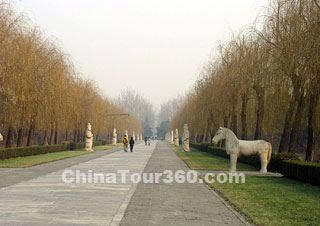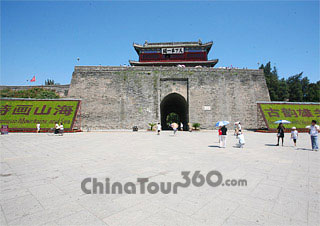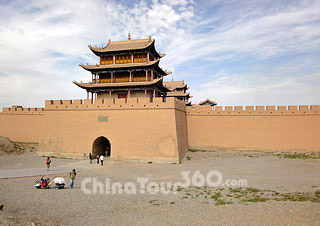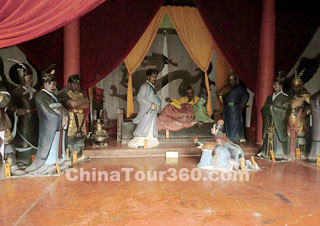In 1368, an eminent peasant leader named Zhu Yuanzhang (Emperor Taizu) - responsible for securing a number of important victories in battles during the rebellions - was crowned emperor and went on to establish the Ming Dynasty (1368 - 1644). The capital was founded in Yingtian (present day Nanjing), although was later relocated further north, in Beijing.
 |
| The Ming Tombs in Beijing |
Opportunities for economic development were readily seized upon by entrepreneurs during the Ming, especially in China's southern regions. Maize and sweet potato only recently introduced into China were widely grown on local farms, which led to increased crop yields. Mining and textiles industries also flourished. Evidence even shows that towards the end of the Ming a capitalist system of production had gradually begun to develop in the region.
The Ming Dynasty also brought with it the completion of the Great Wall. Although construction had started in earlier dynasties, the present-day structure underwent numerous repair work and further additions in the years of the Ming. Spanning the nine provinces of Liaoning, Beijing, Tianjin, Inner Mongolia, Shanxi, Shaanxi, Ningxia and Gansu, the Great Wall winds like a giant dragon across China's northern plains, mountains and deserts. The Ming Dynasty Great Wall extended from the Shanhaiguan Pass, near the Bohai Sea, to the Jiayuguan Pass in Gansu Province. Many more watchtowers were built along the Great Wall, even stretching along the Silk Road.
|
|
Although designed with the intention of protecting China from invasion by northern nomads, the building of the Great Wall still could not prevent the Manchus conquering China in 1644, after Wu Sangui successfully breached the gates of the Shanhaiguan Pass. In the same year Li Zicheng, an uprising leader, captured the capital in Beijing, bringing about the end of the Ming Dynasty.
The relative social stability enjoyed at the peak of the Ming allowed rulers to indulge in the idea that China now represented the pinnacle of civilized culture; doors began to close on efforts to advance technology and learn more about cultures from abroad. This greatly hindered the Ming Dynasty's future development, resulting in its fall in status from that of a prosperous country to one in decline. China also found itself being left behind by other nations in the world.
![]() Foreign Invasions
Foreign Invasions
South-east China's coastal cities suffered a number of attacks at the hands of the Japanese during the Ming, which greatly affected the national economy. However, Qi Jiguang (1528 - 1588), now regarded as a national hero, did eventually manage to rally a successful fight back against the intruders. At the same time, the Portuguese were also launching attacks on these coastal cities. They even succeeded in securing a lease on the running of present-day Macau, although the sovereignty of the region remained in Chinese hands. The Dutch were to go on to invade Taiwan towards the end of the Ming Dynasty; however Chinese control of the region was eventually regained by Zheng Chenggong (1624 - 1662) in 1662.
![]() Great Achievements
Great Achievements
![]() Seafaring
Seafaring
Although the territory covered by the Ming Dynasty was smaller than that of the Yuan, during its peak rulers governed over the Mongols in the north, present-day Xinjiang in the northwest, the Western Regions, Tibet and the Nvzhen tribe in the north-east. Due to its great size, the country attracted the interest of many foreign delegations and parties. Meanwhile, the government assigned a man named Zheng He (1371 - 1433) to make numerous lengthily voyages to countries in Southeast Asia, the Indian Ocean (the Red Sea area) and the east coast of Africa. The unprecedented-scope of these voyages greatly increased the Ming's influence abroad and made Zheng He the forerunning figure in seafaring history.
![]() Science
Science
Xu Guangqi (1562 - 1633), a Ming Dynasty bureaucrat, is famed for his work Nong Zheng Quan Shu, a book which explores methods of agricultural production in China up until the 17th Century. The study made a great contribution to the development of farming techniques in ancient China.
![]() Medicine
Medicine
The Ben Cao Gang Mu (Compendium of Materia Medica) written by Li Shizhen (1518 - 1593) compiled a collection of more than 1,800 categories of materia medica and more than 10,000 prescriptions used throughout China up to 16th Century. The book was commonly referred to as the Compendium of Oriental Medicine.
![]() Geography
Geography
Xu Xiake (1586 - 1641) wrote what is now considered as a classical study of geography called Xu Xiake's Travel Notes. His work includes records of the Karst landform, nearly two centuries earlier than similar records found in Europe.
![]() Literature
Literature
During the late-Yuan and early-Ming, Shi Nai'an (1296 - 1370?) and Luo Guanzhong (1330 - 1400), both famous writers, published the books Outlaws of the Marsh and Romance of Three Kingdoms, which were to be included in the four classic novels of Chinese literature.
|
|
One of China's most famous works, Journey to the West, was also produced at that time by the famous novelist Wu Cheng'en (1500?-1582), and was also included as part of the four classic novels.
Another famous piece of the time was the Yongle Dadian. Written by a collection of Ming Dynasty authors, it is commonly viewed as a precious piece of Chinese cultural heritage, however many pages of the book have been lost as a result of disruption caused by war.
![]() Go to the Qing Dynasty
Go to the Qing Dynasty











